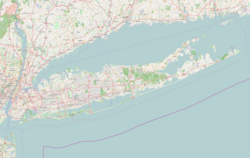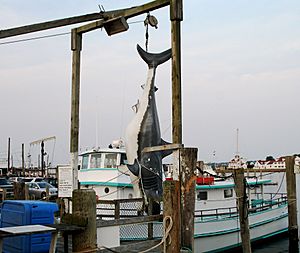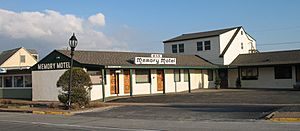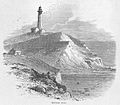Montauk, New York facts for kids
Quick facts for kids
Montauk, New York
|
|
|---|---|
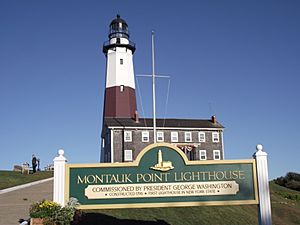
Montauk Lighthouse (2012)
|
|
| Country | United States |
| State | New York |
| County | Suffolk |
| Town | East Hampton |
| Area | |
| • Total | 35.83 sq mi (92.81 km2) |
| • Land | 18.49 sq mi (47.89 km2) |
| • Water | 17.34 sq mi (44.92 km2) |
| Elevation | 33 ft (10 m) |
| Population
(2020)
|
|
| • Total | 4,318 |
| • Density | 233.53/sq mi (90.17/km2) |
| Time zone | UTC−05:00 (Eastern (EST)) |
| • Summer (DST) | UTC−04:00 (EDT) |
| ZIP Code |
11954
|
| Area code(s) | 631, 934 |
| FIPS code | 36-48054 |
| GNIS feature ID | 957540 |
Montauk is a small community and census-designated place (CDP) in Suffolk County, New York. It's located on the eastern tip of Long Island, about 118 miles (190 km) east of Midtown Manhattan. In 2020, about 4,318 people lived there.
Montauk is famous for its beautiful beaches and fishing. It's known as a major tourist spot with six state parks. Many people say it has more world saltwater fishing records than any other port! It's also home to New York state's largest commercial and recreational fishing fleet.
| Top - 0-9 A B C D E F G H I J K L M N O P Q R S T U V W X Y Z |
Montauk's Past: A Look at History
Early Days: The 1600s
Montauk gets its name from the Montaukett tribe, who were the first people to live here. In 1614, a Dutch explorer named Adriaen Block called Montauk Point "Point of the Fishers."
In 1637, the Montauketts joined with New England settlers for protection during the Pequot War. Later, in 1648, the land that would become East Hampton was sold to settlers. The Montauketts kept the lands to the east, including Montauk Point.
Around 1653, the Narragansett-Montaukett War began. The Narragansetts attacked the Montaukett village. White settlers in East Hampton offered the Montauketts a safe place to stay. The fighting ended in 1657. The name Fort Pond Bay comes from a Montaukett "fort" that was once on its shore.
In 1660, the Montaukett leader's widow sold all of Montauk for 100 pounds. This payment was made in "Indian corn or good wampum." The tribe was still allowed to live on the land, hunt, fish, and use parts of whales that washed ashore. They continued to live in an area called "Indian Fields" until the 1800s.
Because Montauk was used for raising livestock, Deep Hollow Ranch is considered the oldest cattle ranch in the United States.
Revolutionary Times: The 1700s
During the American Revolutionary War, a British ship came to Fort Pond Bay in 1775 looking for supplies. An American officer, John Dayton, tricked the British into thinking he had more soldiers than he did. This clever trick is called "Dayton's Ruse."
In 1781, a British ship called the Culloden got stuck near what is now Culloden Point. Its remains were found in the 1970s and are now a historic site.
The Montauk Lighthouse was approved by Congress in 1792 and finished in 1796. It was the first lighthouse in New York state!
The 1800s: Changes and Growth
In 1839, enslaved people who had taken control of the ship La Amistad landed in Montauk. They were looking for food. American authorities found them, and after an important trial, the enslaved people were set free.
In 1879, a man named Arthur W. Benson bought about 10,000 acres (40 km²) of land on the east end of Montauk. He built seven "cottages" designed by Stanford White. One of the most famous is Tick Hall, which was owned by entertainer Dick Cavett for many years.
The first train from the Long Island Rail Road arrived in Montauk in 1895. The idea was to make Montauk a "shortcut" for trips between New York City and London. Ships would dock at Fort Pond Bay, and passengers would take a train to New York City. However, this plan didn't work out because the bay was too shallow.
In 1898, the United States Army bought Benson's property to create Camp Wikoff. This camp was used to keep Army soldiers safe after they returned from the Spanish–American War. Famous soldiers like Theodore Roosevelt and his Rough Riders stayed there.
The 1900s: Development and Disasters
Early 1900s: A Vision for Montauk
In 1924, Robert Moses started setting up state parks in Montauk. These included Hither Hills State Park and Montauk Point State Park.
In 1926, Carl G. Fisher bought most of the East End of Long Island. He wanted to turn Montauk into the "Miami Beach of the North." He built many projects, including:
- Blasting a channel through Lake Montauk to connect it to Block Island Sound.
- Building the Montauk Yacht Club and the Montauk Downs Golf Course.
- Creating Montauk Manor, a fancy hotel.
- Constructing the six-story Carl Fisher Office Building, which is now a residential building called The Tower at Montauk. It's still the tallest occupied building in East Hampton.
Fisher built about 30 buildings between 1926 and 1932, all in a special style called Tudor Revival architecture. Even though he spent a lot of money, he lost his fortune during the Wall Street Crash of 1929, and most of his projects closed down.
In 1938, the Great Hurricane of 1938 caused a lot of flooding. Montauk became an island for a short time. The main downtown area was moved about 3 miles (4.8 km) south, closer to the Atlantic Ocean.
Mid-1900s: Military and Fishing
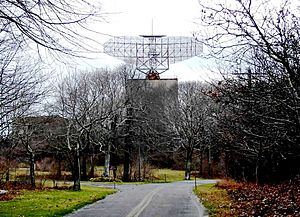
During World War II, the United States Navy bought much of the east end of Montauk for a military base. Fort Pond Bay became a base for seaplanes. The U.S. Army built Camp Hero with large guns to protect shipping lanes. The buildings at the base were designed to look like a fishing village from above.
In 1951, a fisherman named Frank Mundus started leading fishing trips. He became famous for "monster fishing," catching large sharks. This made shark fishing a popular activity in Montauk.
On September 1, 1951, a fishing boat called the Pelican sank off Montauk Point. Forty-five people died. The boat was carrying too many passengers. This disaster led to new rules across the country to prevent fishing boats from being overloaded.
In 1957, the Army closed Camp Hero. The United States Air Force took it over and built a huge radar system there in 1958.
Late 1900s: New Ideas and Closures
In 1959, a company planned to sell affordable prefabricated houses called Leisurama for second homes. Two hundred of these houses were built at Culloden Point in Montauk.
In 1967, the United States Coast Guard wanted to tear down the Montauk Lighthouse. Erosion had made the cliff edge too close to the lighthouse. After many protests, the Coast Guard decided not to tear it down.
In 1982, the Air Force base officially closed. The military started selling off its extra property.
In 1995, a new extreme fishing technique called skishing started in Montauk. It involves wearing a wetsuit and flippers, then swimming into the ocean with a fishing rod to catch fish.
The 2000s: Modern Discoveries
In 2007, a fishing boat found a large 19th-century anchor. People thought it might have been from the ship SS Great Eastern from 1862.
In 2008, a strange animal carcass was found near the town, which people called the "Montauk Monster." Its identity was a mystery!
In 2016, scientists found that the waters off Montauk are a birthing ground for great white sharks.
Montauk's Location and Weather
Montauk covers about 19.8 square miles (51.3 km²). Most of this area is land, with some water.
Montauk has a mild climate because it's right by the Atlantic Ocean. This means winters are warmer and springs and summers are cooler than in places further inland. It's a popular vacation spot, even in winter, for people from New York.
People of Montauk
In 2020, Montauk had a population of 4,318 people. Most residents are White, with smaller populations of African American, Native American, and Asian people. About 16% of the population is Hispanic or Latino.
The average family income in Montauk was about $50,493.
Montauk's Economy: Tourism and Fishing
Montauk is a very popular beach resort. It calls itself "The End" or "The Last Resort" because it's at the very tip of Long Island. It has many restaurants, bed and breakfasts, and hotels. Many hotels are open from April to November, but some are open all year.
You can get to Montauk by train using the Long Island Rail Road. There's also a bus service called Hampton Jitney that goes to Manhattan. Small planes can fly into the Montauk Airport.
Lake Montauk is home to a U.S. Coast Guard station and a fleet of fishing boats. Montauk is known for its fishing, both for fun and for business.
Parks and Fun Things to Do
Montauk has six state parks where you can enjoy nature and outdoor activities:
- Hither Hills State Park
- Shadmoor State Park
- Montauk Downs State Park
- Amsterdam Beach State Park
- Camp Hero State Park
- Montauk Point State Park
There are also other parks like Montauk County Park and areas protected by the Nature Conservancy.
Famous People from Montauk
Many well-known people have lived in or had homes in Montauk:
- Edward Albee (1928 – 2016), a famous playwright.
- Peter Beard (1938 – 2020), a photographer.
- Fred Melamed (born 1956), an actor.
- Paul Simon (born 1941), a singer and songwriter.
- Andy Warhol (1928 – 1987), a famous artist.
- Tuesday Weld (born 1943), an actress.
- Pinchas Zukerman (born 1948), a conductor.
- Rufus Wainwright (born 1973), a singer-songwriter.
Montauk in Pop Culture
Montauk has been featured in many films, TV shows, and songs!
Films
- 1975 – The character Quint from the movie Jaws was based on a shark hunter from Montauk, Frank Mundus.
- 2004 – Montauk is an important place in the movie Eternal Sunshine of the Spotless Mind.
- 2009 – The movie Paper Man takes place in Montauk.
- 2017 – The film Return to Montauk was inspired by a novel about Montauk.
- 2023 – The movie No Hard Feelings is set in Montauk.
Television
- 1997 – In an episode of Friends, the friends go to Montauk to learn about Phoebe's birth mother.
- 2011–15 – A fictional bar in Montauk is a main location in the TV series Revenge.
- 2014–19 – The TV series The Affair is set in Montauk.
- 2016–present – Montauk was the original title and setting for the Netflix show Stranger Things.
Music
- 1975–76 – The Rolling Stones stayed at Andy Warhol's estate in Montauk. Their song "Memory Motel" was written during this time.
- 1990 – Billy Joel's song "The Downeaster Alexa" tells the story of a fisherman's journey from Montauk.
- 2003 – The band Brand New sings about a shipwreck off Montauk Point in their song "Play Crack the Sky".
- 2012 – Rufus Wainwright wrote a song called "Montauk" for his daughter.
Literature
- 1992 – A science fiction novel, The Montauk Project: Experiments in Time, claimed that a radar at Camp Hero was used for time travel experiments. This book has become popular among people interested in conspiracy theories.
- 2005 – In the book The Lightning Thief, Percy Jackson and his mother visit Montauk on vacation.
Images for kids
See also
 In Spanish: Montauk (Nueva York) para niños
In Spanish: Montauk (Nueva York) para niños


